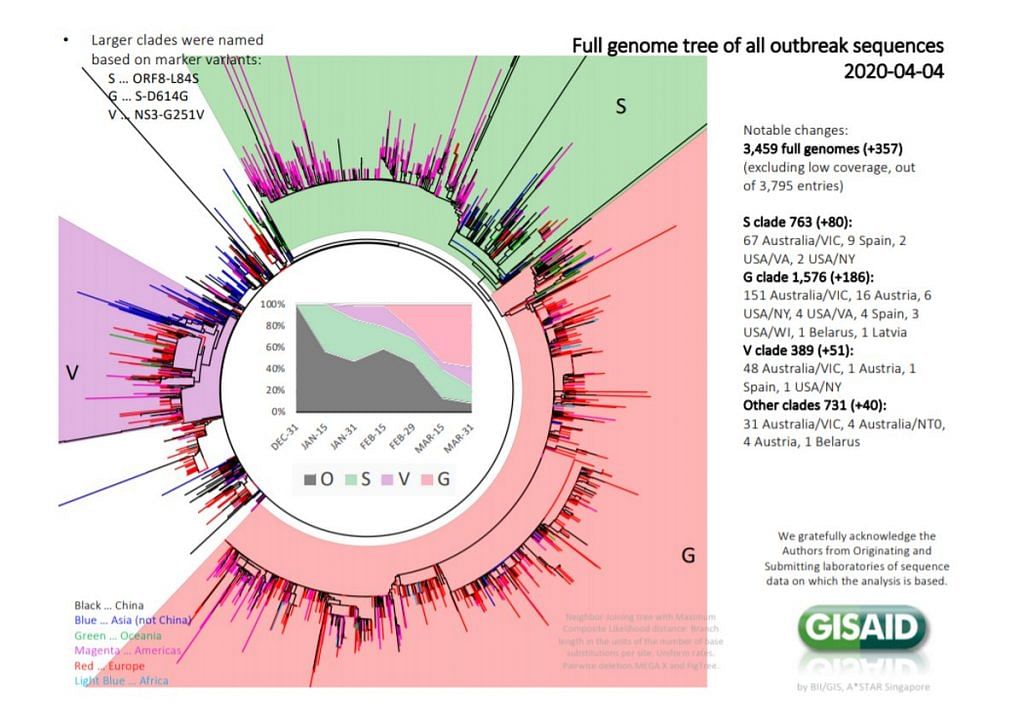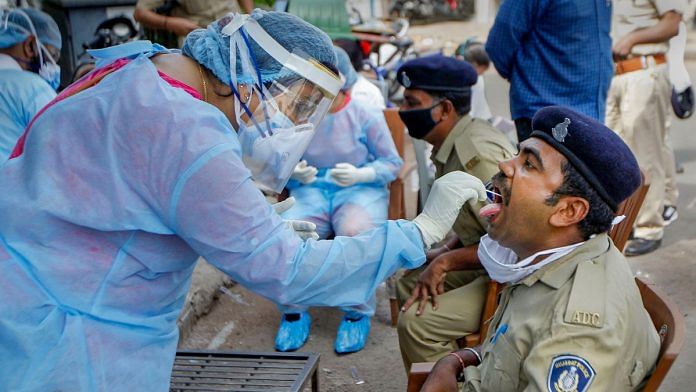Bengaluru: The high mortality rate due to Covid-19 in Gujarat has been attributed to a more virulent strain of the SARS-CoV-2 or novel coronavirus, according to reports that appeared Monday.
The reports quote officials as saying the “L-type strain”, which was widespread in China’s Wuhan, the initial epicentre of the outbreak, is more prevalent in Gujarat, as opposed to the “S-strain”, which is claimed to be less virulent.
However, virologists have repeatedly said there is just one strain of the novel coronavirus. Regular mutations appear in the virus as it evolves and transmits, forming different ‘clades’, but they offer no extra immunity or virulence, according to experts. RNA replication is how the virus multiplies and spreads, and the mutations occur because the process lacks a proof-reading mechanism and is prone to error.
There have been no studies that have successfully established one clade or variant of the virus to be deadlier than the other.
Also read: India’s Covid deaths rise steadily but infection rate fluctuates in states: Data experts
Clades and types
More than strains, ‘L-type’ and ‘S-type’ simply symbolise lineages of the virus from Wuhan — the L-type underwent mutations to change to the S-type. The L-type was previously reported to be “aggressive” in its spread (not virulence), and that has since been updated scientifically to simply be more frequent.
The changes in the virus’ outer structure, which are being referred to as “strains”, are actually called clades.
These clades are named after the mutations that amino acids and proteins undergo on the surface of the virus. The names are made official in GISAID, an open and international collaborative effort to share zoonotic influenza-related genome sequences (and now, SARS-CoV-2 sequences). There are over 5,000 sequences from across the globe uploaded to GISAID. The collaboration is a public–private partnership between the German government, and nonprofit organisation Friends of GISAID.
But both L-type and S-type belong to the same clade, ‘S’. This clade deals with the variation in a gene called ORF8. The mutation itself is called ORF8-L84S, and it changes the amino acid Leucine (L) to Serine (S). These types were obtained from early data in Wuhan.
The clades follow a fixed naming structure: For ORF8-L84S, the ORF8 gene underwent a mutation of the amino acid L at the 84th position of the gene’s protein to the amino acid S.
There are two other named clades today.
Clade ‘G’, where a variant in a gene ‘S’ (unrelated to serine) changes aspartic acid (D) at position 614 of the gene’s protein to glycine (G). Thus, the variant or clade ‘G’ is called S-D614G.
The variant or Clade ‘V’ is labelled NS3-G251V, where the NS3 gene’s glycine (G) at position 251 changed to valine (V).

All other mutations are classified as ‘Other’ or ‘O’ in GISAID. This includes mutations like ORF8-S84L, where S and L mutate in the opposite direction as well.
Also read: Covid-19 fight is a Test match, not a T20. Here’s what India needs to do to win
Variation in virulence or mortality
None of these clades or evolutions within clades indicates any difference in their ability to infect individuals or induce mortality. Many experts as well as reports, including one published by ThePrint, have clarified the lack of correlation between the types and their ability to infect or kill.
The L-type was considered “aggressive” due to its widespread prevalence, which by itself was affected by mobility restrictions and physical distancing measures.
Reports of one “strain” being more deadly than the other have been regularly debunked by virologists online, including by the founders of Next Strain, another public database onto which sequenced genomes are uploaded.
This article by @USATODAY misleadingly states that there are “8 strains of coronavirus” circulating. Because of this our @nextstrain inbox is today full of questions like “if you get one strain of Covid-19 and recover, do you have immunity to the other seven?”. 1/13 pic.twitter.com/y9OW8Mdnsd
— Trevor Bedford (@trvrb) March 30, 2020
In some media reports that appeared in India Monday, Chaitanya Joshi, director of the state-run Gujarat Biotechnology Research Centre (GBRC) in Gandhinagar, which itself sequenced the novel coronavirus and provided data to Next Strain, was quoted as saying that L-type is known to cause higher mortality and that analysis done by scientists abroad have confirmed this.
Joshi, who specialises in veterinary and animal sciences, said, “The coronavirus sample we collected from a patient for genome sequence contained the L-type strain. This strain has a much higher virulence as compared to the S-strain.”
But there has been no such finding in the scientific community.
This unproven theory about varying virulence is frequently used the world over to explain deaths or disease patterns that are not yet understood.
Everywhere magically has a different ‘strain’
1) that’s not how we define strains, and there’s basically no evidence for any difference in virulence once you apply the appropriate denominator (like, you know, actual scientists do)
— Bill Hanage (@BillHanage) April 27, 2020
Soumya Swaminathan, Chief Scientist at the World Health Organization, said there is no proof so far that “strains have anything to do with virulence”.
“Some clades are more prevalent in certain geographical regions than in others. But none of these seems to have any differences in clinical outcome, mortality, virulence, or transmissibility,” she told ThePrint’s Editor-in-Chief Shekhar Gupta at an ‘Off The Cuff’ online conversation Saturday.
“No evidence that strains have anything to do with virulence or clinical severity. So far,” Swaminathan said Monday in a text message when reached by ThePrint.
The media reports of Monday also quoted Atul Patel, an infectious diseases specialist at Sterling Hospital in Ahmedabad, as saying that the L-type was more prevalent in Wuhan and was also responsible for the higher mortality there, just as in Gujarat.
“L is the original Wuhan strain which is more pathogenic and leads to more severe disease and early death. After Wuhan, there was spontaneous mutation of the L strain, which converted to S strain, which is milder, less pathogenic,” he said.
However, it’s the S-type that is considered to be the ancestral variant from which the L-type evolved.
In an emailed response to ThePrint, the GISAID Secretariat said, “GISAID remains concerned about a number of papers and articles on the coronavirus causing COVID-19.”
Referring to one of the reports in the Indian media, which suggested “the existence of a more virulent strain than those presently circulating”, the response said, “Some of these publications overinterpret genomic data obtained through GISAID, some even admit that ‘no research has been conducted to confirm this’ theory, yet they are published.”
GISAID has recently published comments on the discussion of different types or clades of the hCoV-19 virus causing Covid-19, in an article titled ‘Natural evolution of the hCoV-19‘ on its website.
Also read: Tweaking patient’s immune cells to target the virus could be potential therapy: Scientists
Properties and effects no different
There is no evidence of higher mortality due to a specific variant of the virus in Wuhan either. In fact, the original researchers who discovered the L-type and S-type said that the L-type occurred more initially, but quickly reduced in frequency of incidence by early January in Wuhan from enforced physical distancing. But this enabled the older S-type to spread in frequency. This research is not peer-reviewed.
There have been no studies to date that have established in any way that one type or the other of this virus has different properties and causes different effects. All the types are linked very closely in pathology, and do not yet contribute to any evidence of increased mortality.
Also read: India could see last of new Covid cases by July-end, Singapore study predicts using AI, data




How stupid this article claims… The most laughable and pitiable claims to mislead citizens against Gujarat govt. Hope chamchas have some knowledge that people who are vulnerable like diabetes, Heart patients, Diabetic people, old people, kidney failures, are very high in Gujarat cases and due to which the morality rate is high. The mortality rate is all depanded upon Cormoboities and older people getting infected. Not only in Gujarat it’s happening we can see around the world older and Cormoboities people are succumbing to Covid 19. So stop such foolish claims paid Presstitues.
So u want to tell like gujarati’s had election to decide strains of corona!!! As u idiots writing like Gujarat is wrong!!!
Dont know why misinformed media like theprint exist.. oh for the satisfaction of chmchas..
There are strains and ur article is hoax from the line u told L type mutated to S. Alphabetical order doesn’t make L type older.
The moot point of this article is to say GUJRAT IS WRONG..
Modi is the most corrupt leader we unfortunately had and his uneducated virus clan is unfortunately going to defend him every way they can.
This writer is one dumb-head, there are totally 8 strains of the virus world-wide and 2 more look to be mutated from the previous ones. This media is so dumb that they would want to go against everything were Modi has a presence. They don’t care about these viruses, corruption, uneducation, poverty, etc., because they are completely funded by Scamgress and the likes.
You are a complete idiot who didnt even care to read the article before commenting nonsense and I am tired of seeing dumb morons like you all over social media these days.
You are even dumber, to read one biased article and come to conclusion. Check scientific journals. There are at least two defined strains L & S. L .